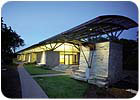
The use of natural stone was a key element to the recent design of the Warren Skaaren Environmental Learning Center at Westcave Preserve in Round Mountain, TX. Jackson & McElhaney Architects were brought on board to create an environmental learning center that incorporated learning opportunities into the design of the architecture, as opposed to static displays or similar methods of learning.
The Warren Skaaren Environmental Learning Center at Westcave Preserve in Round Mountain, TX, serves as a visitor center and classroom space for public and school programs. The building had to be able to accommodate groups of 150 or more students, while also hosting visitor groups of one to 10 people and serving as a community center. The project, designed by Jackson & McElhaney Architects of Austin, TX, was selected as an AIA Committee on the Environment Top Ten Green Project for 2006. Locally quarried limestone from San Jacinto Materials, San Antonio, TX, was a key element in the design of the building.
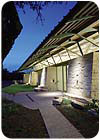
The architects selected Glenrose limestone - from San Jacinto Materials of San Antonio, TX - for the building's exterior veneer, boulder seating and rip/rap retaining walls.
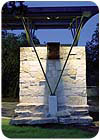
According to architect Michael McElhaney, AIA, it was difficult to integrate the three strata types of stone into a somewhat “natural†appearance, as well as to place the larger boulders at the pylon bases using a forklift.

The stratifying effect used three different ranges of stone sizes for the veneer of the building. Large 24- x 30-inch sizes were used in the lower stratum, medium-sized 12- x 18-inch pieces were used in the middle stratum, and small, thin 1- and 2-inch-thick ledgestones were laid flat in the upper stratum.

McElhaney said it was challenging to align the slots through the stone veneered walls with the summer and winter solstices and the equinox.
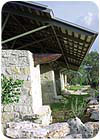
The locally quarried material was selected for its richness in depth and color, and for its shades of yellow and tan.
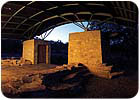
“When the Glenrose limestone is lifted out of the quarry, it breaks with a 'ripple face,' which is actually a 'fossilized sandy beach' pattern from an ancient sea bed,†said McElhaney. “The other face breaks with a nice, even texture. Both faces are used as the finished stone veneer in different components of the building.â€
Overcoming obstacles
According to McElhaney, a few challenges helped make the project “fun and interesting.†Aligning slots through the stone veneer walls with the summer and winter solstices and the equinox; creating a slot in the floor to align with true north, so that a recessed meridian could be constructed to accurately demonstrate the movements of the earth; integrating the three strata types of stone into a somewhat “natural†appearance; and placing the larger boulders at the pylon bases with a forklift, all posed problems for the workers. McElhaney said the challenges were overcome by patience and the successful partnership of owner, contractor and architect.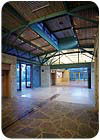
Oklahoma Sugar Loaf sandstone was utilized for the interior flooring in a flagstone pattern. The pattern was efficient to use due to the shape and sizes that are common with this stone type, according to the architect.
Warren Skaaren Environmental Learning Center, Westcave Preserve: Round Mountain, TX
Architect:Jackson & McElhaney Architects, Austin, TXStone Supplier:San Jacinto Materials, San Antonio, TX